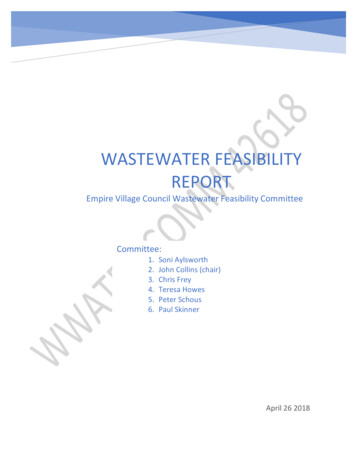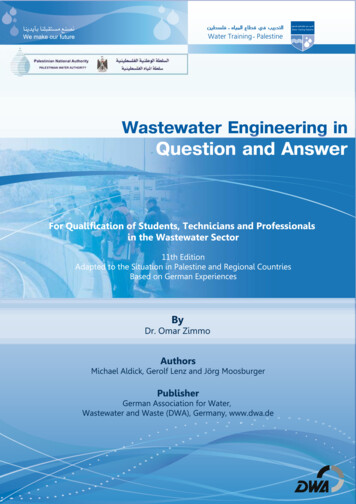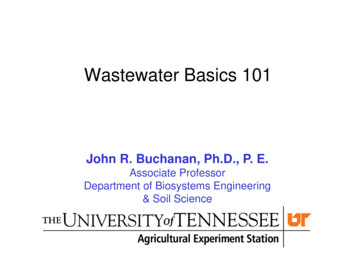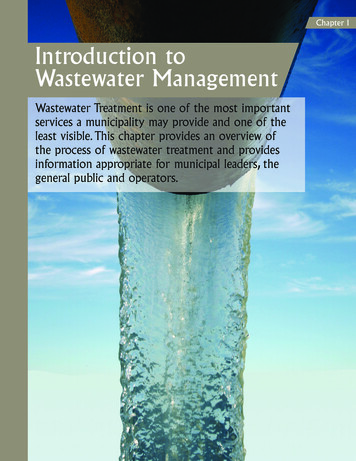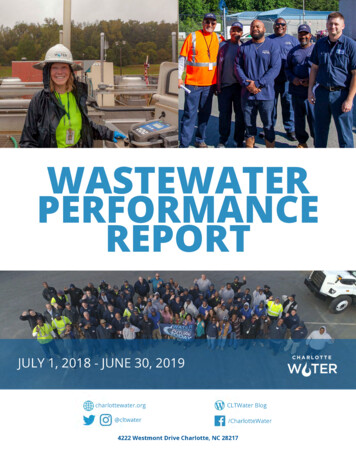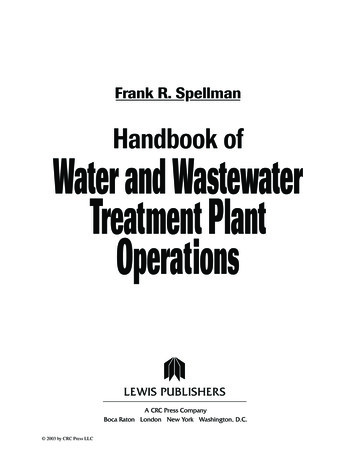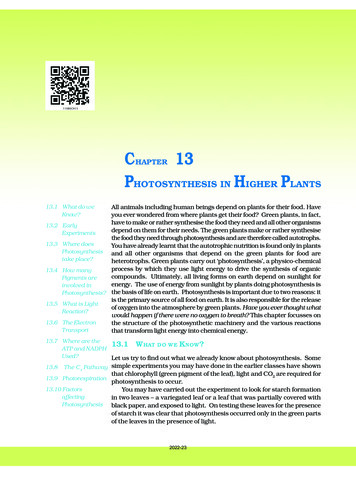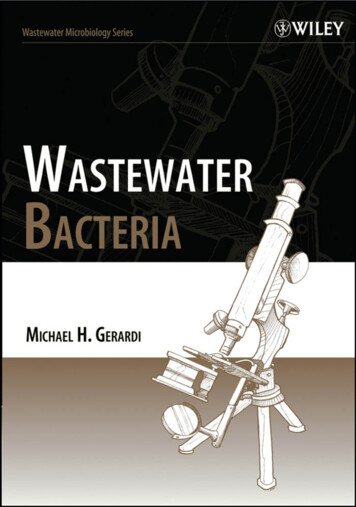
Transcription
Wastewater BacteriaMichael H. GerardiWater Pollution BiologyWilliamsport, PennsylvaniaA JOHN WILEY & SONS, INC., PUBLICATION
Wastewater Bacteria
WASTEWATER MICROBIOLOGY SERIESEditorMichael H. GerardiNitrification and Denitrification in the Activated Sludge ProcessMichael H. GerardiSettleability Problems and Loss of Solids in the Activated Sludge ProcessMichael H. GerardiThe Microbiology of Anaerobic DigestersMichael H. GerardiWastewater PathogensMichael H. Gerardi and Mel C. ZimmermanWastewater BacteriaMichael H. Gerardi
Wastewater BacteriaMichael H. GerardiWater Pollution BiologyWilliamsport, PennsylvaniaA JOHN WILEY & SONS, INC., PUBLICATION
Copyright 2006 by John Wiley & Sons, Inc. All rights reservedPublished by John Wiley & Sons, Inc., Hoboken, New JerseyPublished simultaneously in CanadaNo part of this publication may be reproduced, stored in a retrieval system, or transmitted in any formor by any means, electronic, mechanical, photocopying, recording, scanning, or otherwise, except aspermitted under Section 107 or 108 of the 1976 United States Copyright Act, without either the priorwritten permission of the Publisher, or authorization through payment of the appropriate per-copy feeto the Copyright Clearance Center, Inc., 222 Rosewood Drive, Danvers, MA 01923, (978) 750-8400, fax(978) 750-4470, or on the web at www.copyright.com. Requests to the Publisher for permission shouldbe addressed to the Permissions Department, John Wiley & Sons, Inc., 111 River Street, Hoboken, NJ07030, (201) 748-6011, fax (201) 748-6008, or online at http://www.wiley.com/go/permission.Limit of Liability/Disclaimer of Warranty: While the publisher and author have used their best effortsin preparing this book, they make no representations or warranties with respect to the accuracy orcompleteness of the contents of this book and specifically disclaim any implied warranties ofmerchantability or fitness for a particular purpose. No warranty may be created or extended by salesrepresentatives or written sales materials. The advice and strategies contained herein may not besuitable for your situation. You should consult with a professional where appropriate. Neither thepublisher nor author shall be liable for any loss of profit or any other commercial damages, includingbut not limited to special, incidental, consequential, or other damages.For general information on our other products and services or for technical support, please contactour Customer Care Department within the United States at (800) 762-2974, outside the United Statesat (317) 572-3993 or fax (317) 572-4002.Wiley also publishes its books in a variety of electronic formats. Some content that appears in printmay not be available in electronic formats. For more information about Wiley products, visit our website at www.wiley.com.Library of Congress Cataloging-in-Publication Data:Gerardi, Michael H.Wastewater bacteria / Michael H. Gerardi.p. cm.Includes bibliographical references and index.ISBN-13: 978-0-471-20691-0 (cloth : alk. paper)ISBN-10: 0-471-20691-1 (cloth : alk. paper)1. Sewage sludge digestion. 2. Anaerobic bacteria. I. Title.TD769.G48 2006628.3′54—dc222005031921Printed in the United States of America10 9 8 7 6 5 4 3 2 1
ToRani Harrison
The author extends his sincere appreciation tojoVanna Gerardi for computer supportandCristopher Noviello for artwork used in this text.
ContentsPREFACEixPART I1BACTERIA AND THEIR ENVIRONMENT1 Wastewater Microorganisms32 Microbial Ecology113 Bacteria194 Bacterial Groups335 Bioaugmentation416 Pathogenic Bacteria49PART IIENZYMES AND BACTERIAL GROWTH537 Enzymes558 Hydrolytic Bacteria599 Bacterial Growth65PART IIINITROGEN, PHOSPHORUS, AND SULFUR BACTERIA7510 Nitrifying Bacteria7711 Denitrifying Bacteria91vii
viiiCONTENTS12 Poly-P Bacteria10313 Sulfur-Oxidizing and Sulfur-Reducing Bacteria117PART IV133FLOC FORMATION14 Floc-Forming Bacteria13515 Filamentous Bacteria143PART V153FERMENTATION AND METHANE PRODUCTION16 Fermentative Bacteria15517 Methane-Forming Bacteria161PART VI165TOXICITY18 Septage16719 Toxicity173PART VIIFOAM AND MALODOR PRODUCTION21120 Microbial Foam21321 Biological Malodors22322 Atmospheric Inversions231REFERENCES235ABBREVIATIONS AND ACRONYMS239CHEMICAL COMPOUNDS AND ELEMENTS241GLOSSARY245INDEX251
PrefaceThe basic objectives of wastewater treatment are twofold: (1) Degrade organicwastes to a level where they do not exert a significant, dissolved oxygen demandupon receiving waters and (2) remove nutrients (nitrogen and phosphorus) to levelswhere photosynthetic organisms in receiving waters are limited in their growth. Inorder to achieve these objectives, it is essential for plant operators to understandthe biological processes and organisms involved in wastewater treatment to ensurethat the presence of an adequate, active, and appropriate population of bacteria ispresent in each process. The bacteria are the organisms of primary concern in allbiological processes. However, bacteria in wastewater are not a monoculture but,instead, a diversity of organisms that perform different roles and have differentoperational conditions that are best for their optimal activity and growth (i.e., wastewater treatment).The large diversity of bacteria and the roles that they perform in wastewatertreatment are represented best in two biological treatment units, namely, the activated sludge process and the anaerobic digester. The bacteria and these two biological treatment units are reviewed in this book. The activated sludge process isthe most commonly used aerobic biological treatment unit at municipal wastewatertreatment plants. The organisms here consist of procaryotes (bacteria) and eucaryotes (protozoa and metazoa). The biological processes occur in aerobic and anoxicenvironments and are based on respiration. The anaerobic digester is the mostcommonly used anaerobic biological treatment unit at municipal wastewater treatment plants. The organisms consist exclusively of procaryotes. The biologicalprocesses occur in an anaerobic environment and are based on fermentation. Thereare significant differences in the microbial communities between the activatedsludge process and the anaerobic digester.This book reviews the significant bacterial groups, the roles they perform inwastewater treatment, and the operational conditions that affect their activity. Theroles that are performed by each bacterial group may be beneficial or detrimentalix
xPREFACEto the biological treatment unit and depend upon the operational conditions of theunit. Effective control and proper operation of each biological treatment unit isbased upon an understanding of the basic principles of bacterial activity and growththat are presented in this book.Several of the significant groups of bacteria that are reviewed in this book aredenitrifying bacteria, fermentative (acetate-forming and acid-forming) bacteria,filamentous bacteria, floc-forming bacteria, hydrolytic bacteria, methane-formingbacteria, nitrifying bacteria, poly-P bacteria, sulfur-oxidizing bacteria, and sulfurreducing bacteria. Several of these bacterial groups are presented in comprehensivereviews in other books in the Wastewater Microbiology Series.Wastewater Bacteria is the fifth book in the Wastewater Microbiology Series byJohn Wiley & Sons. This series is designed for wastewater personnel, and the seriespresents a microbiological review of the significant groups of organisms and theirroles in wastewater treatment facilities.Michael H. GerardiState College, Pennsylvania
Part IBacteria and TheirEnvironment
1WastewaterMicroorganismsAlthough most organisms in biological wastewater treatment plants are microscopicin size, there are some organisms such as bristleworms and insect larvae that aremacroscopic in size. Macroscopic organisms can be observed with the naked eye—that is, without the use of a light microscope. Microscopic organisms can only beobserved with the use of a light microscope. Of the microscopic organisms the bacteria (singular: bacterium) are the most important in wastewater treatment plantsand can be seen with the light microscope only under highest magnification. Severalgroups of microorganisms such as protozoa and some metazoa possess large andmore complex cells that can be observed easily with the light microscope withoutthe use of highest magnification. Compared to other organisms, microorganismshave relatively simple structures.All living cells can be classified as procaryotic or eucaryotic (Table 1.1). Procaryotic cells lack a nucleus and other membrane-bound structures, while eucaryotic cells possess these structures (Figure 1.1). The nucleus is the primarymembrane-bound structure in eucaryotic cells. It regulates cellular activity andcontains the genetic information. Examples of membrane-bound structures ororganelles found in eucaryotic cells include the golgi apparatus (which regulates cellular metabolism) and lysomes (which contain hydrolytic enzymes).Based upon cellular structure and function, microorganisms are commonly classified as eucaryotes and procaryotes. The procaryotes consist of (1) eubacteria or“true” bacteria and (2) archaebacteria or “ancient” bacteria (Table 1.2). The eubacteria and archaebacteria are the most important microorganisms in biological,wastewater treatment plants. Together, these two procaryotes commonly arereferred to as bacteria.Wastewater Bacteria, by Michael H. GerardiCopyright 2006 John Wiley & Sons, Inc.3
4WASTEWATER MICROORGANISMSTABLE 1.1Major Differences between Procaryotic Organisms and Eucaryotic OrganismsFeatureGenetic materialOrganellesStructureProcaryotic OrganismEucaryotic OrganismNot contained in a membraneNoneSimpleContained in a membraneManyComplexLysosomeGolgi bodyCell wallNucleolusNucleusNuclear areaCytoplasmRibosomeCell membraneCell membrane(a)(b)FIGURE 1.1 Procaryotic and eucaryotic cells. The procaryotic cell (a) contains no membrane-boundorganelles such as the nucleus, golgi body, and lysosome that are found in the eucaryotic cell (b).TABLE 1.2Classification of Microorganisms in Wastewater Treatment PlantsGroupCell UnicellularUnicellular with uniquecellular chemistryRepresentativesBristleworms, flatworms, free-livingnematodes, waterbearsBacteriaHalophiles, methanogens,thermacidophilesThere are four important eucaryotic organisms in the activated sludge process.These organisms are fungi, protozoa, rotifers, and nematodes.These free-living (nondisease-causing) eucaryotes enter wastewater treatment plants through inflow andinfiltration (I/I) as soil and water organisms.FUNGIFungi usually are saprophytic organisms and are classified by their mode of reproduction. As saprophytes they obtain their nourishment from the degradation ofdead organic matter. Most fungi are free-living and include yeast, molds, andmushrooms.
PROTOZOA5FIGURE 1.2 Filamentous fungi. Filamentous fungi occasionally bloom in activated sludge processesdue to low pH or nutrient deficiency. Filamentous fungi are relatively large in size and display truebranching.Most fungi are strict aerobes and can tolerate a low pH and a low nitrogen environment. Although fungi grow over a wide range of pH values (2–9), the optimumpH for most species of fungi is 5.6, and their nitrogen nutrient requirement forgrowth is approximately one-half as much as that for bacteria.In the activated sludge process filamentous fungi (Figure 1.2) may proliferate andcontribute to settleability problems in secondary clarifiers. The proliferation of filamentous fungi is associated with low pH ( 6.5) and low nutrients. Although filamentous fungi contribute to settleability problems in the activated sludge process,the presence of a large and diverse population of fungi is desired for the treatmentof some industrial wastewaters and composting of organic wastes. Fungi have theability to degrade cellulose, tolerate low nutrient levels, and grow in the presenceof low moisture and low pH conditions.An example of a unicellular fungus is the yeast (Saccharomyces). They reproduceby budding. Budding results in the production of numerous daughter cells (offspring) from one parent cell. Yeast can degrade organic compounds to carbondioxide and water with the use of free molecular oxygen (O2), or as facultativeanaerobes they can degrade organic compounds such as sugars to ethanol(CH3CH2OH) in the absence of free molecular oxygen.PROTOZOAProtozoa are unicellular organisms. Most protozoa are free-living and solitary, butsome do form colonies. Most protozoa are strict aerobes, but some includingamoebae and flagellates can survive anaerobic conditions.In the activated sludge process, protozoa are placed commonly in five groupsaccording to their means of locomotion. These groups are amoebae (Figure 1.3),
6WASTEWATER MICROORGANISMSFIGURE 1.3 Amoeba. The amoeba is a single-celled organism that moves by a pseudopodia (“falsefoot”) mode of locomotion—that is, the streaming of cytoplasm against the cell membrane.FIGURE 1.4 Flagellate. The flagellate is a single-celled organism that moves by the beating actionof one (flagellum) or more (flagella) whip-like structures.flagellates (Figure 1.4), free-swimming ciliates (Figure 1.5), crawling ciliates (Figure1.6), and stalked ciliates (Figure 1.7).Ciliated protozoa are the most important groups of protozoa in the activatedsludge process. They possess short hair-like structures or cilia that beat in unison toproduce a water current for locomotion and food gathering—that is, to bring bacteria into their mouth opening (Figure 1.8). Ciliated protozoa provide the following benefits to the activated sludge process:
PROTOZOA7FIGURE 1.5 Free-swimming ciliate. The free-swimming ciliate is a single-celled organism that movesby the beating action of hair-like structures or cilia that are found in rows that cover the entire surfaceof the organism.FIGURE 1.6 Crawling ciliate. The crawling ciliate is a single-celled organism that moves by thebeating action of hair-like structures or cilia that are found in rows that cover only the ventral or “belly”surface of the organism. Add weight to floc particles and improve their settleability. Consume dispersed cells and cleanse the waste stream. Produce and release secretions that coat and remove fine solids (colloids, dispersed cells, and particulate material) from the bulk solution to the surface offloc particles. Recycle nutrients (nitrogen and phosphorus) through their excretions.
8WASTEWATER MICROORGANISMSFIGURE 1.7 Stalked ciliate. The stalked ciliate is a single-celled organisms that moves by the beatingaction of hair-like structures or cilia that are found in rows that surround only the mouth opening ofthe organism. Some stalked ciliates may grow in a colony, and some by “spring” by means of a contractile filament or myoneme in the posterior portion or “stalk” of the organism.FIGURE 1.8 Cilia surrounding the mouth opening of a stalk ciliated protozoa.ROTIFERS AND NEMATODESRotifers (Figure 1.9) and nematodes (Figure 1.10) are multicellular microscopicanimals (metazoa) that also provide numerous benefits to the activated sludgeprocess. In addition to these benefits provided by the ciliated protozoa, the metazoaburrow into floc particles.The burrowing action promotes acceptable bacterial activ-
ROTIFERS AND NEMATODES9FIGURE 1.9 Rotifer in free-swimming mode.FIGURE 1.10 Free-living nematode.ity for the degradation of substrates in the core of the floc particle by permittingthe penetration of dissolved oxygen, nitrate (NO3 ), substrates, and nutrients. Substrates are the carbon and energy sources used by bacteria for cellular growthand activity. With exceptions, substrates consist of carbonaceous, biochemicaloxygen demand (cBOD) compounds and nitrogenous, biochemical oxygen demand(nBOD) compounds.
10WASTEWATER MICROORGANISMSBACTERIAThe most important organisms in biological, wastewater treatment plants are thebacteria—eubacteria and archaebacteria. Recognition of the distinction betweenthese two groups of organisms or domains (Bacteria and Archaea) is relativelyrecent, and it is common for species of both groups to be referred to as bacteria.Bacteria enter wastewater treatment plants through fecal waste and I/I as soil andwater organisms.The archaebacteria consist of the halophiles, thermacidophiles, and methanogens.Only the methanogens or methane-forming bacteria are of importance in wastewater treatment plants. Methane-forming bacteria stabilize wastes through theirconversion to methane (CH4).Halophiles (salt-loving) or halophilic bacteria are found in saltwater where thesalt concentration (3.5%) is optimum for their growth.These marine organisms needan elevated sodium ion (Na ) concentration in their environment in order to maintain the integrity of their cell wall and an elevated potassium ion (K ) concentration in their cells for proper enzymatic activity. Halophilic bacteria along withcyanobacteria and photosynthetic bacteria produce gas vacuoles. These vacuoles areused to regulate cell buoyancy; that is, they are a cellular floatation device.Thermacidophiles (high-temperature-loving and low-pH-loving) or thermacidophilic bacteria perform no role in wastewater treatment plants. These organismslive in hot acidic environments such as volcanic vents on the ocean floor.
2Microbial EcologyMicrobial ecology as applied to the activated sludge process and the anaerobicdigester is the review of the significant groups of wastewater organisms and theoperational conditions in each biological treatment unit. This review includesthe effects of abiotic and biotic factors upon the organism including their activityand growth—that is, wastewater treatment efficiency. Biological treatment unitsare simply biological amplifiers—that is, the removal or degradation of wasteresults in an increase in the number of organisms (sludge). Therefore, acceptableactivity and growth of the organisms or biomass is acceptable wastewatertreatment.Collectively, all organisms and operational conditions are interrelated by thetransfer of carbon and energy through a food chain (Figure 2.1) or more appropriately a food web (Figure 2.2). Within the food web there are numerous habitats,niches, and relationships (symbiotic and predator–prey) that determine the successor failure of the biological treatment unit to treat wastewater.Abiotic factors are the nonliving components or operational conditions in a biological treatment unit that affect the activity and growth of the biomass. Forexample, a decrease in pH of the activated sludge process favors the proliferationof filamentous fungi and disfavors the growth of bacteria, and a decrease in pH inthe anaerobic digester favors the growth of fermentative bacteria and disfavors thegrowth of methane-forming bacteria. Biotic factors are the living components ororganisms in a biological treatment unit. Each organism has an effect upon otherorganisms (predator–prey and symbiotic relationships) and abiotic factors in thebiological treatment unit. For example, free-swimming ciliated protozoa increase innumber in the presence of large numbers of dispersed bacterial cells. However,during floc formation the number of dispersed bacterial cells decreases and, consequently, the number of free-swimming ciliated protozoa decrease in number. In theWastewater Bacteria, by Michael H. GerardiCopyright 2006 John Wiley & Sons, Inc.11
12MICROBIAL ECOLOGYMethane (CH4)methane-forming bacteriaAcetate, carbon dioxide, hydrogenacetogenic (acetate-forming) bacteriaAlcohols and fatty acidsfermentative (acid-forming) bacteriaSimple sugars, organic acids, and amino acidhydrolytic bacteriaComplex substrates (polysaccharides, lipids, and proteins)in digester sludgeFIGURE 2.1 Transfer of carbon and energy through an anaerobic digester food chain. Carbon andenergy enter the anaerobic digester in the form of large, complex organic molecules such as polysaccharides, lipids, and proteins. These compounds are degraded to smaller and simpler compoundsthrough step-by-step biochemical reactions by a diversity of bacterial groups to methane. Througheach biochemical reaction, bacteria are produced.activated sludge process, nitrifying bacteria decrease alkalinity and pH, while denitrifying bacteria increase alkalinity and pH.In the anaerobic digester, four different groups of bacteria have a symbioticrelationship (Figure 2.3). Fermentative bacteria increase the quantities of carbondioxide and hydrogen (H2), while hydrogenotrophic methane-forming bacteriadecrease the quantities of carbon dioxide and hydrogen. Hydrogenotrophic methaneforming bacteria combine carbon dioxide and hydrogen to form methane. By using
MICROBIAL ECOLOGY13free-living nematodesrotifersprotozoaorganotrophic bacteriacBODnitrifying bacterianBODAlkalinityFIGURE 2.2 Transfer of carbon and energy through an activated sludge food web. Carbon andenergy enter the activated sludge process in the form of cBOD and nBOD and alkalinity. These carbonand energy substrates are used by a variety of organisms in the activated sludge process, and manyof the organisms that grow from these substrates in turn are used as substrates by other organisms.The transfer of carbon and energy in the activated sludge process is between many groups of organisms in a “web-like” pattern.hydrogen to produce methane, the hydrogen pressure in the anaerobic digesterdecreases. This decrease in hydrogen pressure enables acetogenic bacteria toproduce acetate (CH3COOH). Acetoclasitc methane-forming bacteria use acetateto produce methane and carbon dioxide. The hydrogenotrophic methane-formingbacteria also combine the carbon dioxide produced by the acetogenic bacteria withhydrogen to form methane.However, when the hydrogenotrophic methane-forming bacteria are inhibited,the hydrogen pressure increases in the anaerobic digester. The increase in hydrogen pressure inhibits acetogenic bacteria. This results in a decrease in acetate production and consequently a decrease in methane production by acetoclasticmethane-forming bacteria.
14MICROBIAL ECOLOGYOrganic acids and alcoholsfermentative bacteriaacetogenic bacteriaAcetateFatty IGURE 2.3 Symbiotic relationships in an anaerobic digester.ACTIVATED SLUDGE PROCESS, SIGNIFICANT ABIOTIC ANDBIOTIC FACTORSSignificant abiotic factors in the activated sludge process include alkalinity, ionizedammonia (NH4 ), dissolved oxygen, hydraulic retention time (HRT), nutrients, pH,quantity and types of substrates, return activated sludge (RAS) rate, temperature,toxic wastes, and turbulence. Significant biotic factors include denitrifying bacteria,filamentous organisms, floc-forming bacteria, mean cell residence time (MCRT) orsludge age, mixed liquor volatile suspended solids (MLVSS) concentration, nitrifying bacteria, and relative abundance and dominant groups of protozoa.ANAEROBIC DIGESTER, SIGNIFICANT ABIOTIC AND BIOTIC FACTORSSignificant abiotic factors in the anaerobic digester include ionized ammonia(NH4 ), alkalinity, carbon dioxide, hydrogen, nitrate (NO3 ), nutrients, pH, quantityand types of substrates, sulfate (SO42 ), temperature, toxic wastes, and volatile acids.Significant biotic factors include acetogenic bacteria, fermentative (acid-forming)bacteria, hydrolytic bacteria, methane-forming bacteria, solids retention time (SRT),sulfur-reducing bacteria, and volatile suspended solids (VSS).
ANAEROBIC DIGESTER, SIGNIFICANT ABIOTIC AND BIOTIC FACTORS15Within each biological treatment unit, different groups of organisms transfercarbon and energy from one trophic (food) level to the next trophic level (Figures2.1 and 2.2). In the activated sludge process, carbon and energy enter the processas nonliving substrates or BOD. In the soluble form, BOD is absorbed by a varietyof organisms, mostly bacteria. Some of the absorbed BOD is transformed into newbacterial cells (sludge) or living BOD. Each organism in the food chain or food webrepresents BOD, because living organisms are consumed (predator–prey relationships); for example, bacteria are consumed by protozoa and metazoa, and deadorganisms are decomposed by living organisms.As carbon and energy move up the food chain or food web, the quantity (weight)or biomass of each group of organism in the higher trophic level decreases (Figure2.4). With each move to a higher trophic level, more carbon and energy are lost inwaste products and heat, thus leaving less carbon and energy for the synthesis ofcellular material (biomass). However, the transfer of carbon and energy from onegroup of organisms to another is not as simple as a food chain, because severalgroups of organisms often feed off the same substrates or lower trophic level. Thetransfer or movement of carbon and energy here is referred to as a food web. Thefood web better illustrates the activated sludge process than the food chain, becauseorganisms here work mostly side-by-side (Figure 2.2). For example, nitrifying bacteria oxidize nBOD, while organotrophic bacteria oxidize cBOD, and biologicalphosphorus removal occurs, while organotrophic bacteria oxidize cBOD.The food chain better illustrates the anaerobic digester than the food web,because bacteria in the digester work in step-by-step fashion to produce rphic bacteria, nitrifying bacteriacBOD, nBOD, alkalinityFIGURE 2.4 Activated sludge food pyramid. As carbon and energy move up the food pryramid fromone tropic level to the next, a smaller quantity of organisms (biomass) is produced in the higher trophiclevel, due to the loss of some carbon and energy as carbon dioxide and waste products. The lossoccurs as a result of the biochemical reactions involved in the degradation of the substrate (biomass)from the lower trophic level.
16MICROBIAL ECOLOGY(Figure 2.1). Hydrolytic bacteria solubilize complex organic wastes to solublewastes. The soluble wastes then are degraded to simple wastes by fermentative bacteria. These simple wastes finally are converted to methane by methane-formingbacteria.HABITATS AND NICHESEach group of organisms in a biological treatment unit has its own habitat and niche.Changes in operational conditions can decrease or increase the number of niches.The habitat is where the organism lives, and the niche is the role the organism performs in the biological treatment unit. Examples of habitats and niches are numerous in the activated sludge process and the anaerobic digester.Examples of habitats and niches in the activated sludge process include thefollowing: Strict aerobic nitrifying bacteria live (habitat) mostly on the perimeter of thefloc particle where dissolved oxygen concentration is high, and they oxidize(niche) ionized ammonia and nitrite (NO2 ). Floc-forming bacteria live (habitat) throughout the floc particle and agglutinate (niche) bacteria and remove (niche) fine solids and heavy metals from thewaste stream. Floc-forming bacteria also oxidize (niche) soluble cBOD. Pseudomonads (members of the genus Pseudomonas) are found (habitat)throughout the floc particle and oxidize (niche) soluble cBOD in the presenceor absence of free molecular oxygen. Pseudomonads also have the uniqueability to oxidize (niche) toxic phenol and phenolic compounds.Pseudomonas also has the ability to degrade a large variety of substrates; therefore, they are present in large numbers in most wastewater treatment plants. Otherbacteria such as Alcaligenes and Flavobacterium degrade mostly proteins and wouldbe present in large numbers only in wastewater treatment plants that receive largeamounts of proteinaceous wastes. Therefore, due to its ability to degrade a largevariety of substrates, Pseudomonas would be able to occupy a larger number ofniches than Alcaligenes and Flavobacterium. Similarly, due to their larger surfaceto-volume ratio, bacteria can better compete with protozoa for soluble substratesand would be able to occupy a larger number of niches than protozoa.The number of niches in the activated sludge process can decrease or increasewith changes in the following operational conditions: Use of anoxic periods Composition of the wastewater Hydraulic retention times due to daily, weekly, and seasonal variations inhydraulic loadings Return activated sludge ratesExamples of habitats and niches in the anaerobic digester also are numerous andinclude the following:
COMPETITION17 Anaerobic hydrolytic bacteria live (habitat) in a redox environment 100 mVand solubilize (niche) complex organic compounds. Sulfate-reducing bacteria live (habitat) in a redox environment 100 mV andreduce (niche) sulfate (SO42 ) to sulfides (H2S and HS ) and make (niche)sulfur available as a nutrient to anaerobic bacteria. Fermentative (acid-forming) bacteria live (habitat) in a redox environment 200 mV and produce (niche) substrates that can be used by methaneforming bacteria. Methane-forming bacteria live (habitat) in a redox environment 300 mVand remove (niche) carbon dioxide, hydrogen, and acetate from theenvironment.The number of niches in the anaerobic digester also can decrease or increase withchanges in the following operational conditions: Composition of the substrates transferred to the anaerobic digesterTemperaturepH and the form or toxic wastes rendering them more or less toxicHydrogen pressureCOMPETITIONCompetition for a niche is continuous and is a critical factor in determining thesuccess of a biological treatment unit. Competition is better known as the “competitive exclusion principle.” This principle states that only one species can occupyany niche at any time. The species that occupies the niche is the species that canutilize the resources of the environment most efficiently.In the activated sludge process, filamentous organisms such as type 1701 and ty
reviews in other books in the Wastewater Microbiology Series. Wastewater Bacteriais the fifth book in the Wastewater Microbiology Series by John Wiley & Sons.This series is designed for wastewater personnel, and the series presents a microbiological review of the significant groups of organisms and their roles in wastewater treatment facilities.
